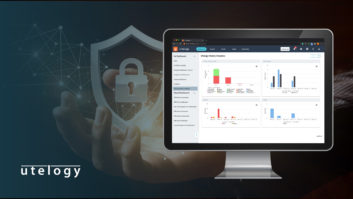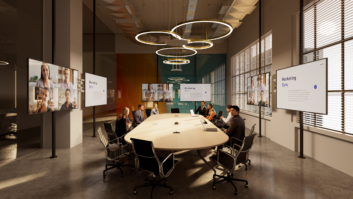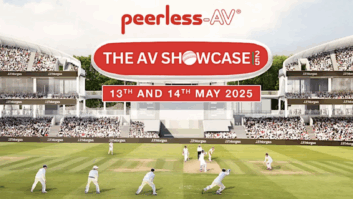When we last took an extended sortie into the world of corporate AV, the impression that emerged was of a sector – like so many others – facing considerable uncertainty in light of the pandemic, but one in which the future of technology deployment was already starting to look very different. Above all, the talk was of greatly increased working from home and hybrid work patterns, with flexibility and high quality – regardless of location and internet quality – were going to be the chief priorities.
The validity of these observations has only been strengthened over the last year, but now there is an extra, discordant note to contend with. That is, simply, that expectations of Covid-19 falling away this year have been replaced by a growing realisation that it could still have a long time left to run. With Omicron pushing case levels to unprecedented heights in many countries, and ‘work at home if possible’ guidance returning, any full-scale return to the office again seems rather distant.
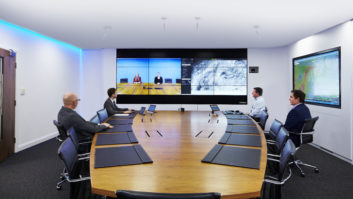 Hence it’s unsurprising that a feeling of uncertainty continues to hang over the sector. For this latest overview, we’ve spoken to systems integrators and consultants, as well as vendors, in order to gain a more comprehensive view of corporate AV’s outlook. And while not without its less positive aspects,
Hence it’s unsurprising that a feeling of uncertainty continues to hang over the sector. For this latest overview, we’ve spoken to systems integrators and consultants, as well as vendors, in order to gain a more comprehensive view of corporate AV’s outlook. And while not without its less positive aspects,
the impression this time is of a sector both wholeheartedly embracing technologies that allow seamless working – whether in the office, at home or another remote location – and taking time to explore new opportunities for collaboration and business process optimisation. Above all, it seems we can expect a major sustained boom in intelligent AV, analytics and sensor technologies.
TARGETED INVESTMENTS
Investments may be more targeted or downsized for a while, and the supply chain crisis is also continuing to affect delivery times and project schedules. But in terms of having the necessary tools and technologies to hand, it seems an increasing number of companies will have taken beneficial steps forward by the time the ‘current unpleasantness’ (in journalist David Hepworth’s memorable phrase) is finally over.
David Raymen, regional business manager at AV integrator Visavvi, offers a particularly concise summary: “As an industry, I think we are experiencing a shift in client requirements rather than a full recovery. [In particular] demand for corporate communication between offices and home workers has never been greater. The tremendous growth of Microsoft Teams, Zoom and Pexip has driven corporate communication and collaboration environments like never before.”
The picture painted by John Ellis, senior manager integrated systems sales at Shure UK, is hardly uncommon. “Overall, I’d say the market is strong with a lot of projects planned, although a number are changing/reconsidering the exact floor and room sizes/layouts,” he says. “Due to hybrid meetings and WFH [work from home], rooms are often being resized, and smaller rooms are being knocked into larger spaces.”
He also confirms that continuing “massive worldwide component and material shortages, added to transportation issues” are affecting project schedules. “Many projects have obviously been delayed or pushed back, but we don’t hear of many projects being cancelled at the moment; some are being downsized certainly,” he says. “Despite product shortages I don’t hear of any slowdown in orders being placed.”
However, longer-term it is inevitable that the downsizing of corporate estates will be a factor of concern. The days of huge corporates buying or renting huge office blocks for permanent ongoing use are surely drawing to an end. Already, there is plenty of evidence that companies are selling off floors in existing premises, or leasing them out to other businesses. This is borne out by recent research from the Chartered Institute of Personnel and Development that 40% of employers expect more than half of their staff to work from home on a regular basis even after the pandemic diminishes.
“With differing WFH policies over different companies, there is talk of companies either not occupying all the spaces they have acquired, or leasing/selling off floors of buildings, and this will probably have a knock-on effect during 2022,” explains Ellis.
 Meanwhile, commercial property search company Realla is not alone in predicting the dramatic growth of Real Estate as a Service (REaaS), where businesses can, the company says, “sign up to membership packages where a certain number of people can use the space each day, enabling either select team members to work from the office or a more flexible arrangement for an entire team.” Realla expects the REaaS model to strengthen, both in design and number.
Meanwhile, commercial property search company Realla is not alone in predicting the dramatic growth of Real Estate as a Service (REaaS), where businesses can, the company says, “sign up to membership packages where a certain number of people can use the space each day, enabling either select team members to work from the office or a more flexible arrangement for an entire team.” Realla expects the REaaS model to strengthen, both in design and number.
This is set to have interesting consequences for the specification of AV systems. It could be that some offices – and, in particular, office conference suites – will be equipped more sparsely, with specific tenants bringing in their own additional AV as required. Certainly, a lot of flexibility in terms of input sources and system configuration is going to be needed. But it really is too early to say with any confidence how this one will play out.
TWO TRENDS
For now, at least, it is possible to highlight two trends that are affecting the vast majority of the corporate space. Perhaps most important is the increased focus on video and audio quality in conferences and collaboration, with steps being taken to achieve more consistency however the meeting is configured. Then, with the ongoing need to have more spacious conference rooms and to accommodate extra technology and more varied usage, smaller office suites are giving way to larger multi-purpose collaboration spaces.
Ellis notes: “Collaboration spaces will increase in scale and size with high quality audio and video required as the demand for hybrid meetings continues. Camera tracking linked to ceiling mounted microphones will increase so hybrid meetings give the remote callers the best experience possible, and everyone in the actual room can be seen and heard clearly by the far end.”
Crestron’s director of technology, Stijn Ooms, depicts a similar set of priorities in the corporate world. Noting the “huge demand” for collaboration solutions that prepare workspaces for “a new hybrid mindset”, he goes on to list a number of technologies on many companies’ radars, including: video conferencing, content sharing, room scheduling, wireless presentation and collaboration, and intelligent video and audio solutions.
These are technologies that, adds Ooms, “deliver a consistent, equal experience in every space, for every participants, management, etc.” In addition, he notes that all projects follow the same trend for simplicity, scalability and easy management.
But it is intelligent video/audio, video analytics and sensoring techniques that he thinks could be most influential in 2022: “Intelligent video and audio because one of the challenges of hybrid working is giving everyone an equal seat at the table – no matter if they are in the office or working from home. [Meanwhile] video analytics will help with people counting so you don’t go over the maximum capacity, but it can on the longer-term also help by using facial recognition and starting the meeting as soon as the organiser enters the room. Sensoring techniques will help to control and improve air quality, but also [provide benefits such as freeing] up a room when it’s booked but remains unused.”
EMPLOYEE CHOICE
Nigel Dunn, Jabra managing director EMEA North, cites the company’s own recent research indicating that where employees have the choice between working from home or in an office, 75% want to be able to work from anywhere in the future. This translates to demand for multiple technologies that “bring teams together in new and engaging ways”, but like Ooms, Dunn tends to place the greatest emphasis on one particular area of development.
“Intelligent video conferencing solutions are transforming the way we work, bringing teams together in new and engaging ways that increase productivity and keep staff motivated,” he says.
“We are working in distributed teams more than ever before, with a growing reliance on virtual collaboration to get work done. Video meetings are 40 per cent more productive than audio only, according to Aragon Research. However, to deliver real benefits, solutions need to deliver a seamless, high-quality user experience. For example, video conferencing with a 180-degree field-of-view, so that everyone is in the picture and can actively participate, and intelligent features that can automatically adjust the frame according to what’s happening in the meeting so that nobody misses out.”
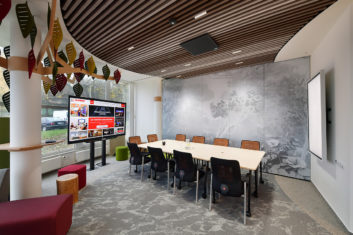 AI and analytics are set to be fundamental parts of the mix as well, not least by helping companies make informed decisions about optimising the use of their spaces. Dunn adds: “Jabra’s PanaCast 50 video conferencing camera has the intelligence to monitor numbers and meeting room capacity. Software generates anonymous room occupancy data, helping to optimise space and improve the utilisation of meeting rooms.”
AI and analytics are set to be fundamental parts of the mix as well, not least by helping companies make informed decisions about optimising the use of their spaces. Dunn adds: “Jabra’s PanaCast 50 video conferencing camera has the intelligence to monitor numbers and meeting room capacity. Software generates anonymous room occupancy data, helping to optimise space and improve the utilisation of meeting rooms.”
Echoing Ellis’ sentiments, Dunn points to analytics as a primary enabler of these developments: “Companies will increasingly rely on intelligent software and real-time analytics to manage the quality of communications with customers.”
GREATER STANDARDISATION
A consistent user experience – regardless of location or bandwidth conditions – is also alluded across the board. In this regard, the logic of a move towards greater standardisation of solutions and underlying technologies is hard to deny.
For Visavvi, Raymen observes: “There has been a lot of focus on working from home and hybrid working, but many organisations see standardisation and the user experience as pivotal to their business operations. More and more clients are looking for enterprise-wide standardisation of meeting environments, and it’s something Visavvi has championed for several years.
“It just makes sense, if users can walk in and use the technology in the room easily regardless of room size or location it greatly improves the user experience, drives adoption, increases return on investment, and ultimately makes organisations and businesses more effective.”
Drawing attention to Visavvi’s own QuickFire range of solutions – covering the “vast majority of meeting room requirements” – Raymen also points to the ‘as a service’ model achieving greater traction. “AVaaS from Visavvi provides all the hardware, professional services and support via subscription. This allows organisations to upgrade and change the facilities within the life of the contract, thereby ensuring they are always fit for purpose.”
DEEP THINKING
Christian Bozeat, director of AV and IT consultancy MACOM (GmbH), also senses a willingness by companies to think deeply about their use of AV into the long-term future. “They do see the need to think about how AV fits into their workstream from a process perspective,” he says. “What do we need to do, and how do we achieve it? Those are the kind of questions that are being asked.”
Questions of user experience also reach beyond collaboration and into areas such as brand presentation and messaging. “There does seem to be a change in what people are looking at – away from traditional corporate offices and more towards experience,” says Bozeat. “[There are signs that] corporates are looking at how to deliver their messages in physical and remote manners, including how they can bring in people and customers to experience their brand from a remote location.”
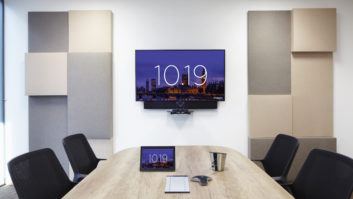 UK-based and with an operation in Dubai, Engage Works is also very much focused on the notion of experience – albeit with an emphasis on immersive and interactive virtual destinations and facilities such as museums. A recent move towards greater activity in software development has certainly helped the company during the pandemic.
UK-based and with an operation in Dubai, Engage Works is also very much focused on the notion of experience – albeit with an emphasis on immersive and interactive virtual destinations and facilities such as museums. A recent move towards greater activity in software development has certainly helped the company during the pandemic.
“The good thing from our perspective is that [since 2020] we have pivoted more towards software,” explains CEO Steve Blyth. “When people began to shift their spending away from hardware – [including] because people couldn’t get into the office – we were developing more software-based working tools. For example, we have an immersive platform for doing virtual events, called enso, that we are now adapting to suit hybrid working.”
Industry-wide, it’s likely that we will see more and more of these comprehensive virtual platforms that allow people to work effectively and flexibly. As Blyth notes: “There is a big focus on the whole experience of working in the office and working at home, and ensuring that everyone has the same level of experience – clients, employees and so on.”
PERMANENT STUDIOS
Back in the more physically-oriented realm, there are signs that some of the larger corporates requiring what are effectively broadcast-grade production facilities are moving away from renting spaces at third-party facilities for specific projects or events, towards developing their own permanent in-house studios. “I think that some are tired of spending sums like £40K per day to use [third-party facilities] and are therefore looking at developing their own,” opines Blyth, indicating that client/partner gatherings and client pitches are among the likely applications.
So unless anyone still doubts it, this all means that the centrality of good communications and collaboration platforms to businesses has only been further underlined over the past two years. As Raymen says: “The new normal is that clients across all sectors have moved from thinking of video communication and collaboration technology as a ‘nice to have’ to an essential part of business technology. Rarely do organisations deploy meeting room environments these days without some sort of provision for communication and collaboration capabilities. Most clients are now setting budgets based on or around communication capabilities.”
He also agrees with the suggestion that ultra-high resolution (UHD) displays and other collaborative systems are likely to rise in popularity as hybridisation matures: “With a focus on equal inclusions, especially in a hybrid or an online meeting environment, the interest [in] UHD for communication and collaboration facilities makes sense. Within the software environment of Teams, Zoom and Pexip, more and more creative, intuitive and natural automatic image framing is being developed. Very high pixel rated cameras provide the perfect performance to enable these platforms to maximise the flexibility of software-developed framing where real-time image manipulation delivers a more inclusive and natural experience of meetings without user intervention. This in turn drives meeting productivity, effectiveness and user adoption.”
 Growing complexity of collaboration solutions and (in some cases, hugely) increased demand for remote access capabilities means that network management is also high on the agenda. With a recent spike in the number of major network breaches adding to concerns about security as well, the need for IT and AV departments to collaborate more seamlessly will be acute.
Growing complexity of collaboration solutions and (in some cases, hugely) increased demand for remote access capabilities means that network management is also high on the agenda. With a recent spike in the number of major network breaches adding to concerns about security as well, the need for IT and AV departments to collaborate more seamlessly will be acute.
A shift is already taking place at some companies, indicates Ellis: “IT and AV departments will essentially develop closer working relationships. [We are] already seeing some AV departments being absorbed (for better or worse) into IT departments. [Also] off-prem cloud-based set-ups will become more and more evident. IT suppliers/dealers will become more involved in AV as companies increasingly look for a one-stop shop. This raises challenges for the more traditional AV integrator.”
That’s a big question for another day. More imminently, the supply chain crisis – which, as the first part of our report into the integrated circuits shortage underlined from page 20, is expected to continue throughout 2022 – is continuing to provide challenges to all industry groups. Notes Ellis: “Every manufacturer wants the whole shortage situation to go away, but at the same time manufacturers have to continue to develop new products. One can see that with the increase of networked AV systems, more and more products will be software-based and network-capable with security paramount. [There will also be increased demand] for no touch solutions and ease of use so users can walk up and just talk and get on with the meeting.”
WELLNESS ISSUES
What is happening in the corporate world is clearly not restricted to technology matters. Wellness and quality of life issues are now more salient issues in society. Business models are going to change – sometimes dramatically – and all this during a period when the economic outlook is arguably less uncertain than at any time since World War II. So there is a big role for AV companies in providing support and guidance to corporate clients when so many existential questions cannot yet be answered.
According to Ooms: “Companies were already moving toward this activity-based employment model, with some fully remote workers and others in the office on a part-time basis, and the pandemic just accelerated that trend. We fully expect it to continue in 2022 – research tells us that a wide majority of executives envision a hybrid business environment going forward.
“As a result, we see a huge rise of projects that include a complete ecosystem that fits the needs of an end-to-end solution for the hybrid work environment. Not only do they include video in every space, [easy] management and an intuitive user experience, but they also look at room scheduling, ho-desking and equipping the home office.”
 For the foreseeable future, the health and safety ramifications of Covid-19 are likely to loom large for corporates whatever their size or scale. And as with all post-crisis periods, it’s probable that previous business levels will be restored more quickly in some other sectors and territories than others.
For the foreseeable future, the health and safety ramifications of Covid-19 are likely to loom large for corporates whatever their size or scale. And as with all post-crisis periods, it’s probable that previous business levels will be restored more quickly in some other sectors and territories than others.
Prior to last December, says Blyth, there was a lot more activity, generally. “It might be that some contracts were being rescaled a bit or delayed, but overall things were moving again. Then in December, when Omicron really began to kick off, new activity started to go on pause again. There was a [renewed feeling] of tentativeness and nervousness. But before December I think a lot of businesses were getting ready for gold!”
Hopefully, the more buoyant situation in one specific region – the UAE – provides a glimmer of what a more sustained recovery might look like globally. Citing Dubai – where the World Expo event is still running through until the end of March, and is giving a lot of focus to the corporate community – Blyth comments: “The Expo has been pretty busy and although I do see some projects being downscaled, a lot of work is going ahead – [especially on the] experiential side. Things are picking up and I don’t see that stopping.”

